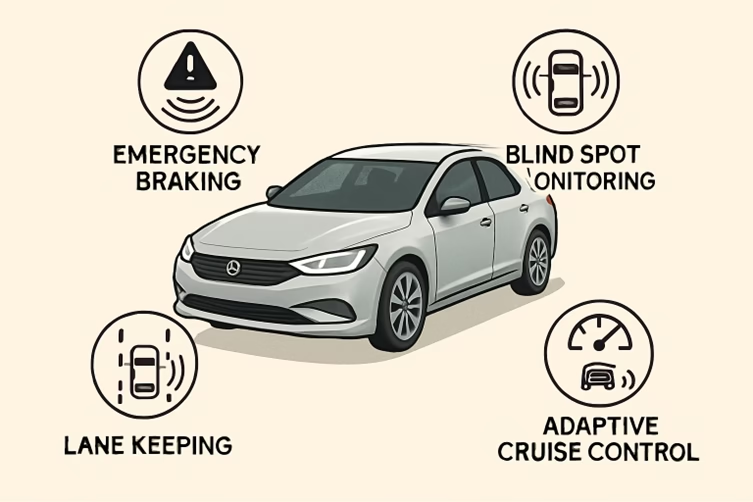Automotive technology rapidly advances safety features, transforming driving into a more innovative and safer experience.
These innovations, including AI-driven systems and advanced connectivity, go beyond traditional seatbelts and airbags.
They focus on accident prevention and driver assistance, making roads safer for everyone.
Learn more at Ryan Chevrolet for more information on these advancements.
Automatic Emergency Braking (AEB)
Automatic Emergency Braking is one of the most significant advancements in automotive safety.
This feature uses forward-facing sensors, such as radar and cameras, to detect an imminent collision and automatically applies the brakes if the driver is too slow or fails to react.
The widespread adoption of AEB is expected to prevent thousands of accidents annually, drastically reducing the severity of rear-end collisions.
According to the National Highway Traffic Safety Administration (NHTSA), all new cars must have AEB by 2029, highlighting its essential role in automotive safety.
Explore safety resources and expert analyses from trusted automotive authorities to learn more about how Automatic Emergency Braking works and its impact on driver and passenger protection.
Lane-Keeping Assist with AI Enhancement
Lane-keeping assist is designed to prevent unintentional lane drift, a frequent factor in highway accidents.
Modern systems have leveraged artificial intelligence to accurately differentiate between purposeful lane changes and unintentional drifting.
By analyzing the driver’s patterns—such as turn signal use and steering wheel movement—AI-enhanced lane-keeping ensures timely and appropriate interventions.
This intelligent system reduces unnecessary alerts and improves the driving experience, making highways significantly safer.
Driver Monitoring Systems (DMS)
Distracted and fatigued driving remain the leading causes of traffic accidents.
Driver Monitoring Systems aim to counter this by using interior cameras and sensors to track the driver’s face, eye movements, and even physiological metrics.
It provides real-time alerts if the system detects signs of drowsiness, distraction, or sudden health issues.
These systems in 2025 models can detect micro-sleep episodes and changes in heart rate, integrating health monitoring with road safety to proactively prevent potential accidents.
Blind Spot Detection with Cross Traffic Alerts
Blind Spot Detection uses radar sensors to monitor areas around the vehicle that may be invisible to the driver.
When another car enters the blind spot, audible, visual, or haptic alerts are issued.
Newer systems now include cross-traffic alerts, which are handy when backing out of parking spaces or driveways.
These features give drivers added confidence and awareness, especially in urban settings with dense traffic and limited visibility.
Adaptive Cruise Control with Stop-and-Go Functionality
Adaptive Cruise Control (ACC) maintains a set speed while using radar and cameras to keep a safe distance from vehicles ahead.
Enhanced stop-and-go functionality allows the car to come to a complete stop in heavy traffic and start moving again without driver intervention.
This reduces driver fatigue in congested conditions and lowers the risk of rear-end collisions.
Adaptive cruise is a shining example of how automation and convenience can directly enhance safety.

Collision Avoidance Steering Assist
Collision Avoidance Steering Assist adds an active layer to traditional collision-avoidance technologies.
When emergency braking is not enough, these systems calculate the safest direction to steer and momentarily take control of the wheel to guide the vehicle out of harm’s way.
Such split-second decisions can be lifesaving, especially in scenarios involving sudden road obstacles or unexpected maneuvers by other drivers.
Connected Vehicle-to-Everything (V2X) Communication
Connectivity is increasingly a hallmark of modern cars. Vehicle-to-Everything (V2X) communication networks allow cars to interact with each other, infrastructure, and even traffic signals.
These networks alert drivers about nearby hazards—like road conditions, emergency vehicles, or sudden stops—ahead of time, enabling proactive safety responses.
As V2X infrastructure develops, its potential to significantly reduce accidents continues to grow.
AI-Powered Predictive Maintenance
AI-powered predictive maintenance is changing the way vehicles are maintained and serviced.
By constantly analyzing real-time data from sensors embedded throughout the car, these systems can forecast when a component will likely fail.
Drivers receive alerts ahead of time, reducing the likelihood of breakdowns and potentially hazardous situations.
Predictive maintenance keeps vehicles running smoothly and plays a key role in overall road safety by preventing unexpected mechanical failure.
Driving Toward a Safer Future
Integrating advanced safety features in today’s vehicles reshapes how we approach road safety.
These innovations, from Automatic Emergency Braking to AI-powered predictive maintenance, work together to prevent accidents, reduce driver fatigue, and enhance situational awareness.
As technology continues to evolve, drivers benefit from more intelligent systems that assist and anticipate potential hazards.
Embracing these modern safety advancements helps make every journey more secure, reinforcing the commitment to protecting lives on the road.

With over 5 years of experience, Minnie J. McGuire covers sports news, offering sharp insights on games, teams, and athletes.


